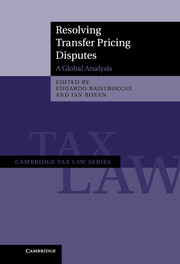Book contents
- Frontmatter
- Contents
- List of figures
- List of tables
- List of contributors
- Acknowledgements
- The Golden Bridge: analytical table of cases by topics in the OECD Guidelines
- Table of Cases
- Abbreviations
- Part I The context of transfer pricing disputes
- Part II North America and Europe
- 3 Transfer pricing disputes in the United States
- 4 Transfer pricing disputes in Canada
- 5 Transfer pricing disputes in the European Union
- 6 Transfer pricing in Germany
- 7 Transfer pricing in Spain
- 8 Transfer pricing disputes in the United Kingdom
- Part III Asia Pacific
- Part IV BRIC Countries
- Part V South America, Middle East and Africa
- Part VI Conclusion
- Index
5 - Transfer pricing disputes in the European Union
from Part II - North America and Europe
Published online by Cambridge University Press: 05 November 2014
- Frontmatter
- Contents
- List of figures
- List of tables
- List of contributors
- Acknowledgements
- The Golden Bridge: analytical table of cases by topics in the OECD Guidelines
- Table of Cases
- Abbreviations
- Part I The context of transfer pricing disputes
- Part II North America and Europe
- 3 Transfer pricing disputes in the United States
- 4 Transfer pricing disputes in Canada
- 5 Transfer pricing disputes in the European Union
- 6 Transfer pricing in Germany
- 7 Transfer pricing in Spain
- 8 Transfer pricing disputes in the United Kingdom
- Part III Asia Pacific
- Part IV BRIC Countries
- Part V South America, Middle East and Africa
- Part VI Conclusion
- Index
Summary
Background
Over the last twenty-five years the European Union has instigated two major initiatives aimed at producing a more coherent direct tax framework for Europe in order to support its key objective of creating a single economic market.
In 1990 the European Commission asked a Committee of Independent Experts on Company Taxation, under the chairmanship of Onno Ruding (Ruding Committee) to determine whether differences in business taxation among Member States led to major distortions which might affect the functioning of the single market, and to examine possible remedial measures. The Report, which was produced in 1992, made a large number of recommendations for improvements in the functioning of business taxation across the EU, including such then far-reaching ideas as cross-border loss relief, but for a variety of reasons, many of them perhaps associated with the desire for the retention of sovereignty over direct tax policy prevalent in many Member States, very little progress was made on any of the key recommendations.
- Type
- Chapter
- Information
- Resolving Transfer Pricing DisputesA Global Analysis, pp. 165 - 187Publisher: Cambridge University PressPrint publication year: 2012

